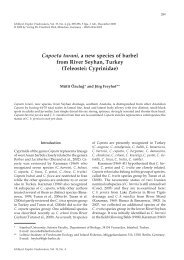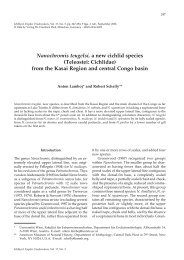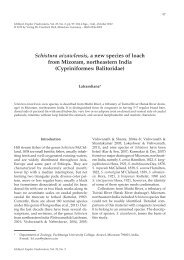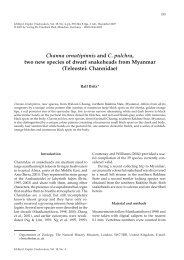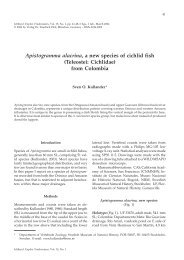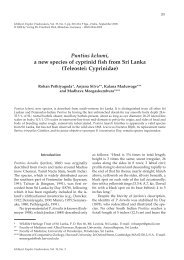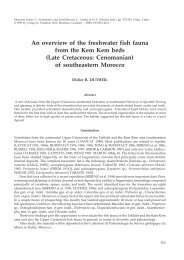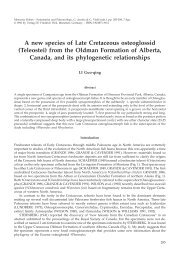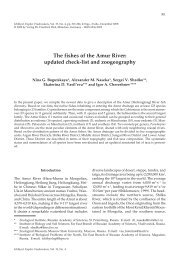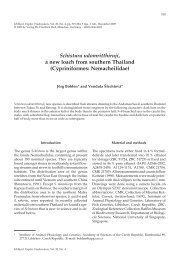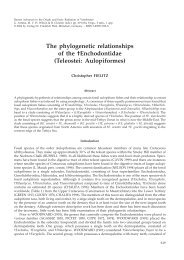A synopsis of the South Asian fishes referred to Puntius - Verlag Dr ...
A synopsis of the South Asian fishes referred to Puntius - Verlag Dr ...
A synopsis of the South Asian fishes referred to Puntius - Verlag Dr ...
You also want an ePaper? Increase the reach of your titles
YUMPU automatically turns print PDFs into web optimized ePapers that Google loves.
<strong>Puntius</strong> Hamil<strong>to</strong>n, 1822<br />
Type species. Cyprinus sophore Hamil<strong>to</strong>n, 1822<br />
(Fig. 2).<br />
Diagnosis. A genus <strong>of</strong> cyprinid <strong>fishes</strong> differing<br />
from all <strong>South</strong> and Sou<strong>the</strong>ast <strong>Asian</strong> genera <strong>of</strong><br />
Cyprininae by <strong>the</strong> combination <strong>of</strong> <strong>the</strong> following<br />
characters and character states: adult size usually<br />
less than 120 mm SL; maxillary barbels absent<br />
or present, rostral barbels absent; dorsal fin with<br />
3-4 unbranched and 8 branched rays; anal fin<br />
with 3 unbranched and 5 branched rays; last<br />
unbranched dorsal-fin ray weak or strong, apically<br />
segmented, not serrated (Fig. 3c); lateral line<br />
complete, with 22-28 pored scales on <strong>the</strong> body;<br />
free uroneural present (Fig. 3d); gill rakers simple,<br />
acuminate (not branched or laminate); no antrorse<br />
predorsal spinous ray; a post-epiphysial fontanelle<br />
present (Fig. 3b; but see remarks on P. bimaculatus<br />
and P. titteya, below); supraneurals 4;<br />
infraorbital 3 slender (Fig. 3a); 5th cera<strong>to</strong>branchial<br />
narrow; pharyngeal teeth 5 + 3 + 2; 12-14 abdominal<br />
and 14-16 caudal vertebrae; and a colour<br />
pattern that includes a (sometimes faint) black<br />
spot or blotch on <strong>the</strong> caudal peduncle.<br />
Remarks. Based on <strong>the</strong> comparisons made herein<br />
(Fig. 1) and <strong>the</strong> data <strong>of</strong> Shantakumar & Vishwanath<br />
(2006) and Kullander (2008), we include<br />
<strong>the</strong> following <strong>South</strong> <strong>Asian</strong> species in <strong>Puntius</strong>:<br />
P. chola (Hamil<strong>to</strong>n, 1822), P. dorsalis (Jerdon, 1849),<br />
P. kelumi Pethiyagoda, Silva, Maduwage & Meegaskumbura,<br />
2008, P. layardi (Gün<strong>the</strong>r, 1868),<br />
P. mahecola (Valenciennes, in Cuvier & Valenciennes,<br />
1844), P. pugio Kullander, 2008, P. sophore<br />
(Hamil<strong>to</strong>n, 1822), P. terio (Hamil<strong>to</strong>n, 1822) and<br />
P. <strong>the</strong>rmalis (Valenciennes, in Cuvier & Valenciennes,<br />
1844).<br />
Because <strong>the</strong>y share <strong>the</strong> external characters<br />
diagnostic <strong>of</strong> <strong>Puntius</strong>, we tentatively retain <strong>the</strong><br />
following <strong>South</strong> <strong>Asian</strong> species in that genus:<br />
P. amphibius (Valenciennes, in Cuvier & Valenciennes<br />
1842), P. arenatus (Day, 1878), P. burmanicus<br />
(Day, 1878), P. cauveriensis (Hora, 1937),<br />
P. crescentus Yazdani & Singh, 1994, P. kamalika<br />
Silva, Maduwage & Pethiyagoda, 2008, P. madhusoodani<br />
Krishnakumar, Pereira & Radhakrishnan,<br />
2011, P. melanostigma (Day, 1878), P. mudumalaiensis<br />
Menon & Rema Devi, 1992, P. muzaffarpurensis<br />
Srivastava, Verma & Sharma, 1977, P. narayani<br />
(Hora, 1937), P. parrah (Day, 1865), P. sahyadriensis<br />
Silas, 1953, P. vittatus (Day, 1865) and P. waa<br />
Ichthyol. Explor. Freshwaters, Vol. 23, No. 1<br />
73<br />
geni (Day, 1872). We also tentatively retain in<br />
<strong>Puntius</strong> P. denisonii (Day, 1865) and P. chalakkudiensis<br />
Menon, Rema Devi & Thobias, 1999, for<br />
which we lacked material for DNA and osteological<br />
analysis: <strong>the</strong>y possess a strikingly different<br />
coloration and mouth shape <strong>to</strong> all o<strong>the</strong>r congeners<br />
(Menon et al., 1999) and are likely <strong>to</strong> warrant<br />
placement in a separate genus in <strong>the</strong> future.<br />
Two species, P. bimaculatus (Bleeker, 1863a)<br />
and P. titteya Deraniyagala, 1929, that differ from<br />
all <strong>the</strong> o<strong>the</strong>r <strong>Puntius</strong> examined by lacking a postepiphysial<br />
fontanelle (Fig. 4b) and possessing only<br />
7 branched dorsal-fin rays, are never<strong>the</strong>less retained<br />
in <strong>Puntius</strong> (see Discussion).<br />
<strong>Puntius</strong> sophore (Hamil<strong>to</strong>n, 1822)<br />
(Fig. 2)<br />
Cyprinus sophore Hamil<strong>to</strong>n, 1822: 310, 389, pl. 19.<br />
Neotype. ZRC 35064, 71.8 mm SL; Bangladesh:<br />
Srimangal [= Sreemangal] <strong>to</strong>wn market, from Hail<br />
Hoar floodplain near Moulvi Bazaar; D. Hoggarth,<br />
Mar 1993.<br />
Topotypes. ZRC 35065-35069, 5, 59.4-80.6 mm<br />
SL, same data as neotype.<br />
Description <strong>of</strong> neotype. General body shape and<br />
appearance are illustrated in Fig. 2a. Morphometric<br />
data <strong>of</strong> neotype and 5 <strong>to</strong>potypes are given in<br />
Table 3; characters <strong>of</strong> <strong>to</strong>potypes, where different<br />
from neotype, are given in paren<strong>the</strong>ses. Body<br />
s<strong>to</strong>ut, standard length about 2.4 times maximum<br />
depth, laterally compressed. Dorsal pr<strong>of</strong>ile <strong>of</strong><br />
head concave above eye; dorsal pr<strong>of</strong>ile <strong>of</strong> body<br />
convex, rising steeply from occipital, almost<br />
horizontal at dorsal-fin origin. Ventral con<strong>to</strong>ur <strong>of</strong><br />
body convex <strong>to</strong> anal-fin insertion, almost horizontal<br />
at pelvic-fin origin. Dorsal and ventral<br />
pr<strong>of</strong>iles <strong>of</strong> caudal peduncle concave <strong>to</strong> terminal<br />
scales on tail base. Caudal peduncle length 1.3<br />
(1.2-1.4) times its depth.<br />
Head short, its length about one-fifth standard<br />
length, somewhat compressed laterally. Eyes<br />
located forward <strong>of</strong> centre, superiorly on head,<br />
just visible in ventral and dorsal views. Nares<br />
dorsolaterally orientated. Mouth U-shaped in<br />
ventral aspect, subterminal, small, angle <strong>of</strong> gape<br />
not reaching below anterior nares in lateral aspect.<br />
Lips fleshy, entire, adnate <strong>to</strong> jaws. Upper lip<br />
overhanging lower one. Barbels absent.




